Editor’s note: This guide was originally published in 2014. It has been updated for accuracy and to reflect modern practices.
When it comes to developing audience personas for a business, the process can be as long (and as expensive) as you allow it to be.
However, for SEO marketing campaigns, the traditional way is often too time-consuming, too resource-intensive, and simply unnecessary for the needs of a digital agency like ours.
For all of these reasons and more, Inflow has developed our own in-house process to get the information we need about our clients’ existing and potential audience segments.
In this guide, we’ll explain how we do it and how you can replicate this process to quickly create your audience personas on a budget. As a bonus, we’ll also share a few of our templates to help you organize your data and kickstart your persona-writing journey.
Let’s get started.
Inflow is an award-winning SEO agency that has served content wins for hundreds of brands over the last 16 years. To learn how we can help your brand succeed, schedule a free consultation now.
Table of Contents
What is an Audience Persona?
An audience persona — also known as an audience profile or buyer persona — is a detailed description of an imaginary person used to represent the relevant characteristics of a particular audience segment.
An audience segment is the aggregate of many existing and potential customers who have certain characteristics in common (e.g. age, gender, interest, occupation).
Typically, “traditional” marketing personas are incredibly in-depth, requiring months of research and a hefty budget (some brands reportedly spend $80,000 to $250,000 for this process!).
Usually, they’re developed after months of comprehensive surveys, focus groups, and interviews asking real people — especially real customers — about their likes, dislikes, roadblocks, goals, and demographic information. This data is combined with highly targeted, accurate reports from companies like Nielsen and Gallup to create a full picture of a brand’s ideal customer(s).
However, for many midsize brands, these surveys, studies, and proprietary data are often cost-prohibitive. This level of research and analysis is simply not feasible when brands are looking to attract and convert their target audience as soon as possible.
So, we’ve developed a shorter, quicker, and more budget-friendly version that’s just as effective for getting our clients the information they need.
Inflow’s Abbreviated Audience Personas
Let’s face it, most digital marketing teams don’t have the time or budget to spend on robust audience personas. In our experience, most clients are willing to invest somewhere between $1,000 and $10,000 in this project — and are working on an accelerated timeline to improve traffic, conversions, and overall revenue.
Even when those clients are ready to invest substantial time and money, traditional personas and the data they provide don’t always serve their marketing needs!
Let me explain:
Traditional marketing personas are heavily focused on nailing down the right audience demographics and detailing the behaviors, motivations, goals, and frustrations shared by a segment. Influencers and media consumption habits are sometimes included in this narrative, but with a limited focus.
In addition, these personas typically only include existing and potential customers.
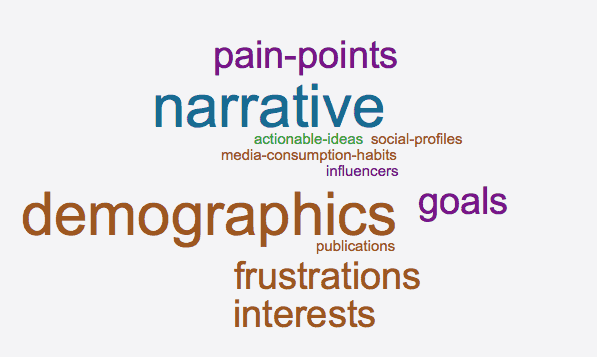
When it comes to crafting digital marketing strategies for our clients, we’ve found ourselves requiring more data on influencers, websites, and other publications associated with each segment.
Thus, we’ve adjusted the traditional persona-building process accordingly — while simultaneously keeping the cost down by using free data sources and spending less time on the narrative.
With this heavy emphasis on influencer research, we often create personas based on segments that don’t match the definition of existing or potential customer. This is because influencers, while important, are often well beyond needing a client’s product or service, yet they are still a potential audience for content.
One example: While SEOs and inbound marketers aren’t typically Inflow clients, this blog about audience profiles has been developed for them because they influence our potential clients.
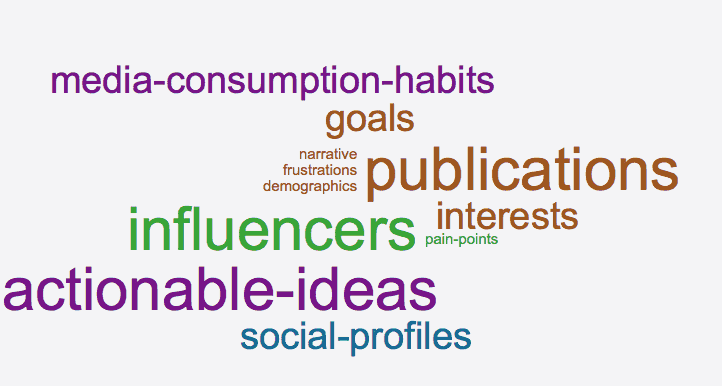
While audience profiles are certainly helpful to have around, the real value of putting them together is that we get to know our clients’ potential and existing customers — as well as the influencers who may not ever become customers, but who can help us reach the other segments.
This leads organically to actionable ideas that we help the client implement to reach their goals.
Audience Profile Example: Donnie the Director
Before going into the nuts and bolts of how we make this happen, let’s look at an example.
The series of screenshots below represent different sections of one audience persona: Donnie the (Funeral) Director.
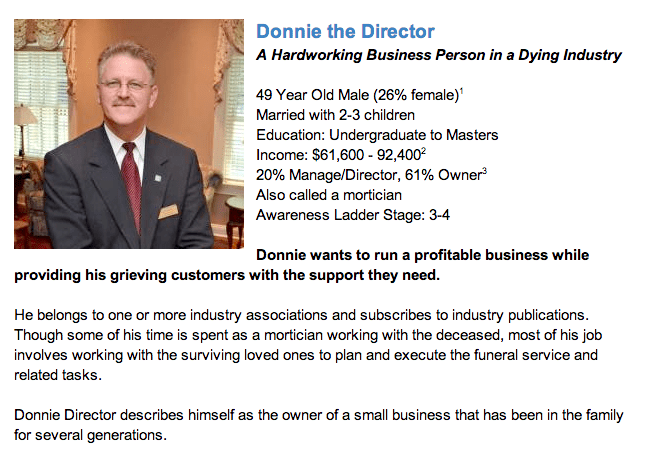
In many ways, this introduction is very similar to traditional personas. However, note that we don’t go into as much depth about “pain points,” “values,” and “goals,” especially when the information is not readily available through our limited research.
Of course, we make sure to cite anywhere that we do find our data, to substantiate our demographic assumptions and narrative.

We’ll detail more of our favorite sources later in this blog, which typically include case studies and white papers from industry organizations, statistics from the Bureau of Labor Statistics, and industry publication media kits.
We incorporate these resources into other areas of the profile, as well.
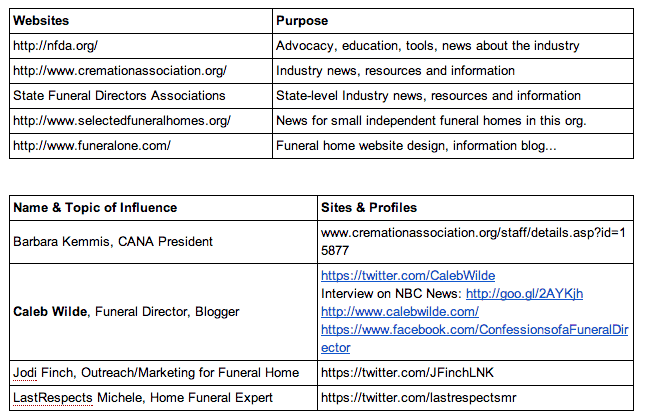
The two sections above are really the backbone of our personas when it comes to informing our content marketing efforts, because the data helps us answer three crucial questions about that customer base:
- Who is this audience?
- Where do they go for information?
- Who do they listen to online?
After all this research is complete, we summarize our findings with several “actionable” ideas and insights that will help us get our client’s brand, message, and content in front of the segment represented by the profile.
![Marketing Notes about Donnie Director's Segment: The best way to reach this segment is probably going to be industry-related websites/blogs and print trade publications, as well as a select few social influencers. Actionable example findings from this profile: Barbara Kemmis, Cremation Association of North America (C A N A) president, invited Inflow to do a case study about [our client], which they will send out in a newsletter to all of their members, which consists mostly of "funeral directors" and "morticians". Reach out to Caleb Wilde about partnering on a piece about how to use social media in a considerate way to market a funeral home business. It would combine his expertise in social for this niche with our expertise in online marketing for our client. Publish this piece on a funeral industry website, such as http://blog.funeralone.com or http://funeralbusinessadvisor.com. Update and repurpose the piece about how to write the digital assets section of a will to include access to social media profiles and other online accounts so the executer can delete the profiles in the event of your death. Pitch it to a retirement or financial planning site (e.g. A A R P.com, Kiplinger.com, Bankrate.com...).](https://www.goinflow.com/wp-content/uploads/2014/07/prersona-actionable-examples.png)
This emphasis on influencers and industry leaders is crucial for building brand authority and awareness, especially in the age of EAT SEO. When you associate your client’s brand (which may be relatively unknown in their industry) with well-known industry influencers and other established brands, it builds relationships that you can’t get by just paying someone for a link.
Getting influencer buy-in isn’t always necessary(or even possible, but it can usually be done if you provide value to the influencer in some way (by shared exposure, for example). Consider it a more communication-intensive, but ultimately cheaper, way to promote content when compared with PPC, social, and display advertising.
As the PR industry experts put it: “Nothing we say about ourselves is as influential as someone else saying it about us.”
Creating Target Audience Personas The Inflow Way
To help you replicate our budget-conscious, time-saving way of building personas, I’ve detailed our agency’s process below. I’ve also included a few downloadable templates and resources from our internal experts to get you started.
While we’ll use language referring to our process for agency clients, you can easily take these learnings and adjust them for your marketing team’s perspective, if you’re building personas for an internal brand or business.
Step 1: Create Your Audience Segments.
As mentioned above, audience profiles are based on audience segments. These segments can come from a variety of sources, including what the client tells you when asked to describe their target customers. Beware of stopping there, however.
A client that sells landscaping supplies might say “Our customers are landscapers and DIY homeowners,” which is technically correct — but they could be missing out on a lot of other great opportunities.
What about the people responsible for purchasing supplies for parks and recreation departments all over the country? What about golf course groundskeepers?
And, by the way, did you know that they’re actually called “golf course superintendents,” and they have an industry organization called the Golf Course Superintendents Association of America (GCSAA), which publishes a PDF report on industry budgets?
And, did you know that, according to Superintendent Magazine’s media kit, their readers are interested in “new products and technology” for golf course groundskeeping?
In other words, sometimes the client doesn’t know what they don’t know.
Here’s how we approach this segment ideation portion of an audience profile project:
- Ask the client to describe their different types of customers in as much detail as they can.
- Ask the client if they would like to branch out and attract slightly different types of customers and, if so, to please describe them.
- Ask the client’s call center supervisor or customer service manager to provide information about common complaints, reasons for returns, and questions they receive from existing customers.
- Review Google Analytics 4 data, especially the Demographic Details report.
- Review SparkToro data. Free searches will allow you to view a certain amount of sample data; you can upgrade to a subscription for more insights.
- Brainstorm any additional potential customer segments and send them to the client for review and feedback.
- Brainstorm any potential audience segments that are not likely to become customers (such as influencers).
- For example, a skate shop may want to reach professional skaters who will probably never shop with them — but who could introduce their brand to thousands of potential customers via their fanbase by participating in an interview, giveaway, or some other strategic partnership.
Step 2: Gather Your Audience Data.
Once you have the list of segments, it’s time to start gathering data about them.
Don’t start writing the personas just yet! You still don’t know much about each segment and may waste a lot of time wondering what to do next or trying to “make up” enough fluff to fill in the gaps.
To organize your data, we recommend using a simple spreadsheet with a row for each segment and a column for each data point. You can make a copy of our Audience Research Template, which includes separate tabs for audience demographics, influencers, and content ideas. (Feel free to customize it for your needs.)
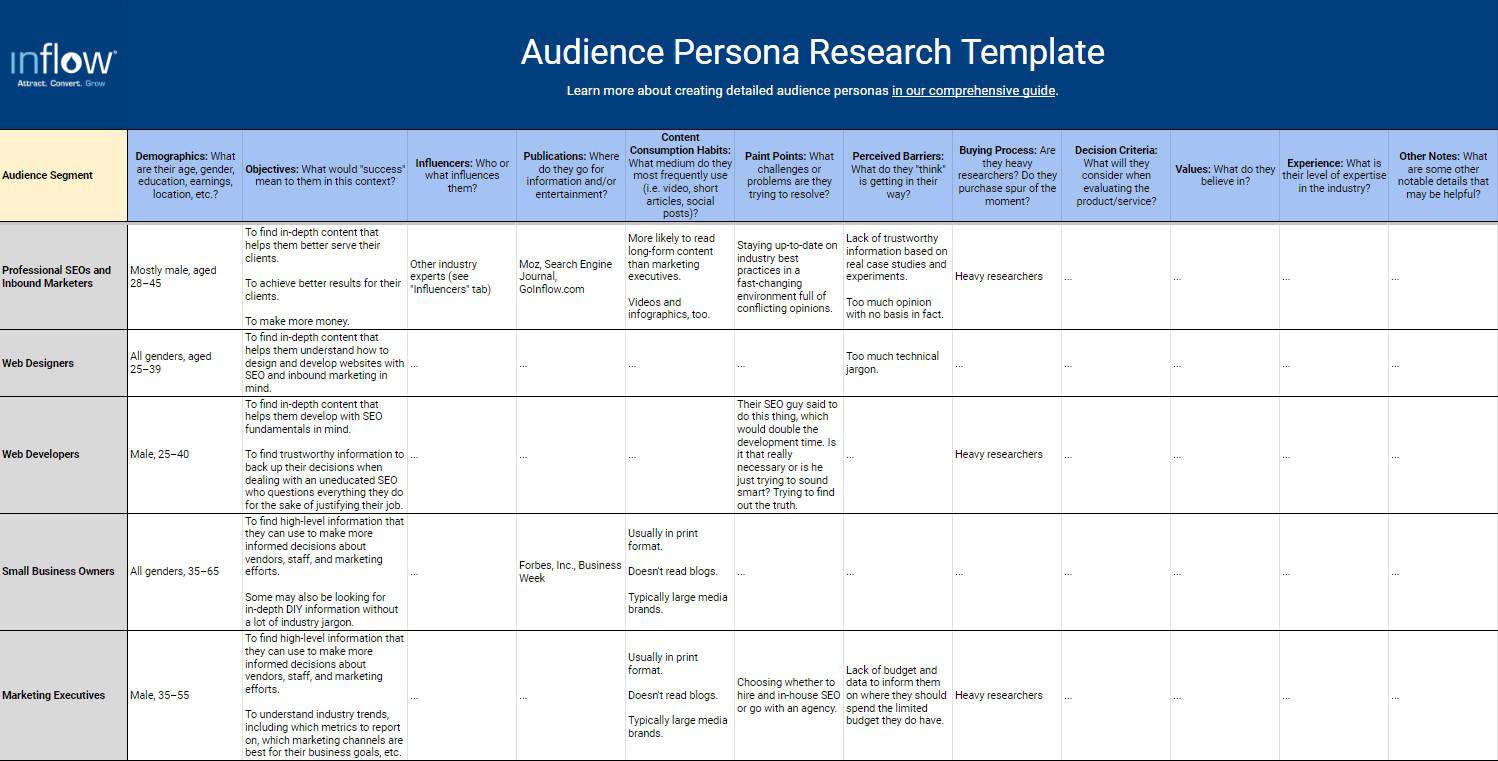
Not every cell needs to be completed — but, as you collect data for various segments, it helps to have an organized place to put all of your information and thoughts.
Data Sources
Once you have the list of segments (which are to become personas) and a place to put the data, it’s time to start filling in the blanks.
Here at Inflow, we typically rely on a few types of data sources to conduct our audience research. To maximize a small client budget, most of these are free, but some do offer additional insights and data for the cost of a subscription or a purchase.
The Client
Your client should be your foremost source of information. Hopefully, they know their customers better than anyone else, so lean on stakeholders, customer service teams, and any in-house marketers to get a lay of the land.
The Customers
If they’re available to you, customers are obviously an ideal source of information for your research. If it’s within the client’s budget and timeline, consider interviewing a few loyal customers or setting up a survey/focus group to learn more about their psychographic data, preferred content types, and more.
Knowing that customer interviews tend to fall on the pricier and more time-intensive side of the audience research process, we can (and have) switched those out for research conducted with the resources listed below.
Industry Organizations

Look for reports by organizations with data on the client’s particular industry (such as the GCSAA example from earlier). You may need to purchase some reports, but you can often get them for free if you explain that you’re writing an article about their data, as these organizations often exist in part to promote the industry in the media.
Search Google for queries like (site:IndustryDomain.org report), (site:IndustryDomain.org survey), (site:IndustryDomain.org demographics), (site:IndustryDomain.org statistics), or (site:IndustryDomain.org study).
If all else fails, pick up the phone.
Industry Publications
Look for media kits by trade publications, which mirror the demographics of the industry they serve. Sometimes this can be a one-stop-shop for all of the free demographics data you need for a given segment.
Search Google for queries like (site:PublicationDomain.com “media kit”) or check the footer links for “Media Kit” or “Advertising.”
Audience Research Tools
There is no shortage of tools out there to aid in your audience analysis. We’ve included just a few of our favorites below.
Client Performance Data
Most clients have a wealth of information at their fingertips, even if they don’t know it. As long as you have access to these platforms, you can find loads of audience data.
Third-Party Tools
- SparkToro: Analyze your website visitors or explore your target market’s preferred channels and interests.
- Quantcast’s Measure Tool: You must place the script on your site to get the most useful data.
- Google Trends: Explore related websites, searches, regional interests, etc.
- Semrush and Ahrefs: View competitive analytics, related keywords, and basic demographics.
- SimilarWeb: Conduct basic domain research, including referring sites, next sites, and user demographics.
- Uber Suggest: Find searches related to your audience’s top queries to uncover entry points.
- Fedica: Analyze your social media followers, including their demographics and brand affinity.
- Klear: Evaluate demographics data by interest or skillset of Twitter users.
- Facebook Search: You can see pages liked by people who liked any other page (i.e. “People who liked Inflow also liked Moz and Hubspot.”).
Other Helpful Resources
- U.S. Bureau of Labor Statistics: Statistics for popular industries (real estate, legal, construction, military, teachers, sales, etc.).
- U.S. Census Bureau: Industry- and region-specific data.
- Pew Research Center: Great for political and economic data.
- Think With Google: Consumer behavior surveys and research conducted by Google. Great for certain niches (travel, online shopping, etc.)
- Google Public Data: Data/statistics from government resources around the world.
- Marketing Charts: A goldmine of data, with reports like “time spent social networking” by age, gender, marital status, etc.
Step 3: Write Your Personas.
When all the research is complete and the data is gathered, it’s time to create your audience personas.
When we’ve done our research right, creating these personas is simply a matter of adding imagination and creativity to the data we already have. Give your audience segment a catchy name (typically, these are alliterative) and detail all of their information in one document.
As mentioned above, target audience profiles can be as long or as short as you need them to be. We tend to write one short intro, and then summarize all further customer data in charts and other visually appealing formats.

You can always use audience persona templates like Hubspot’s Make My Persona to expedite this step, as well.
Putting Your Personas Into Action
With personas in place, we can create a more informed content and SEO marketing plan for our clients, using our knowledge of pain points, funnel stages, and other key metrics.
If you use our Audience Research Template for your ideation, we recommend moving your content ideas to a more detailed content calendar like our Persona Topic Matrix. This way, you can organize your opportunities and more clearly see any gaps you need to fill. (You can download that template for free here.)

Remember: The more detailed your audience research and audience personas are, the more useful they’ll be to your marketing teams.
But, in an industry where time and money are often scarce, even a quick-and-dirty audience persona can do wonders for your brand strategy.
